Potřebujeme váš souhlas k využití jednotlivých dat, aby se vám mimo jiné mohly ukazovat informace týkající se vašich zájmů. Souhlas udělíte kliknutím na tlačítko „OK“.
ASTM E2611-09
Standard Test Method for Measurement of Normal Incidence Sound Transmission of Acoustical Materials Based on the Transfer Matrix Method
Automaticky přeložený název:
Standardní zkušební metoda pro měření normální dopad přenos zvuku akustických materiálů o převodu Matrix metoda založená
NORMA vydána dne 1.3.2009
Informace o normě:
Označení normy: ASTM E2611-09
Poznámka: NEPLATNÁ
Datum vydání normy: 1.3.2009
Kód zboží: NS-45727
Počet stran: 14
Přibližná hmotnost: 42 g (0.09 liber)
Země: Americká technická norma
Kategorie: Technické normy ASTM
Kategorie - podobné normy:
Anotace textu normy ASTM E2611-09 :
Keywords:
4-microphone, impedance tube, normal incidence, transfer function, transfer matrix, transmission loss, ICS Number Code 17.140.01 (Acoustic measurements and noise abatement in general)
Doplňující informace
| Significance and Use | ||||||||
|
There are several purposes of this test: For transmission loss: (a) to characterize the sound insulation characteristics of materials in a less expensive and less time consuming approach than Test Method E 90 and ISO 140-3 (“reverberant room methods”), (b) to allow small samples tested when larger samples are impossible to construct or to transport, (c) to allow a rapid technique that does not require an experienced professional to run. For transfer matrix: (a) to determine additional acoustic properties of the material; (b) to allow calculation of acoustic properties of built-up or composite materials by the combination of their individual transfer matrices. There are significant differences between this method and that of the more traditional reverberant room method. Specifically, in this approach the sound impinges on the specimen in a perpendicular direction (“normal incidence”) only, compared to the random incidence of traditional methods. Additionally, revereration room methods specify certain minimum sizes for test specimens which may not be practical for all materials. At present the correlation, if any, between the two methods is not known. Even though this method may not replicate the reverberant room methods for measuring the transmission loss of materials, it can provide comparison data for small specimens, something that cannot be done in the reverberant room method. Normal incidence transmission loss may also be useful in certain situations where the material is placed within a small acoustical cavity close to a sound source, for example, a closely-fitted machine enclosure or portable electronic device. Transmission loss is not only a property of a material, but is also strongly dependent on boundary conditions inherent in the method and details of the way the material is mounted. This must be considered in the interpretation of the results obtained by this test method. The quantities are measured as a function of frequency with a resolution determined by the sampling rate, transform size, and other parameters of a digital frequency analysis system. The usable frequency range depends on the diameter of the tube and the spacing between the microphone positions. An extended frequency range may be obtained by using tubes with various diameters and microphone spacings. The application of materials into acoustical system elements will probably not be similar to this test method and therefore results obtained by this method may not correlate with performance in-situ. |
||||||||
| 1. Scope | ||||||||
|
1.1 This test method covers the use of a tube, four microphones, and a digital frequency analysis system for the measurement of normal incident transmission loss and other important acoustic properties of materials by determination of the acoustic transfer matrix. 1.2 The values stated in SI units are to be regarded as standard. No other units of measurement are included in this standard. 1.3 This standard does not purport to address all of the safety concerns, if any, associated with its use. It is the responsibility of the user of this standard to establish appropriate safety and health practices and determine the applicability of regulatory limitations prior to use. |
||||||||
| 2. Referenced Documents | ||||||||
|
Podobné normy:
Historická
15.6.2012
Historická
1.8.2013
Historická
15.6.2012
Historická
1.2.2013
Historická
15.1.2008
Historická
1.3.2014


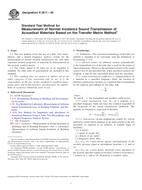
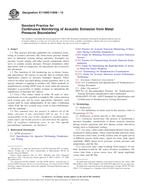 ASTM E1139/E1139M-12..
ASTM E1139/E1139M-12..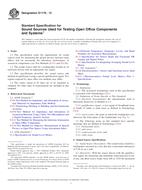 ASTM E1179-13
ASTM E1179-13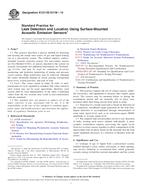 ASTM E1211/E1211M-12..
ASTM E1211/E1211M-12..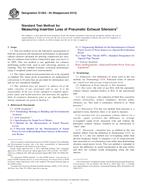 ASTM E1265-04(2013)..
ASTM E1265-04(2013)..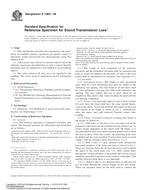 ASTM E1289-08
ASTM E1289-08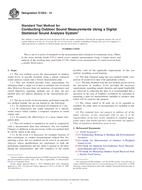 ASTM E1503-14
ASTM E1503-14
 Cookies
Cookies
